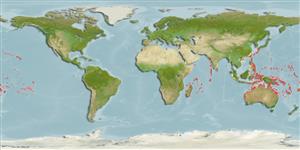Classification / Names
Common names | Synonyms | Catalog of Fishes (gen., sp.) | ITIS | CoL | WoRMS | Cloffa
Actinopterygii (ray-finned fishes) >
Albuliformes (Bonefishes) >
Albulidae (Bonefishes) > Albulinae
Etymology: Albula: Latin, albus = white (Ref. 45335).
Environment / Climate / Range
Ecology
Brackish; reef-associated; oceanodromous (Ref. 51243); depth range ? - 10 m (Ref. 89972). Tropical, preferred ?; 32°N - 32°S, 42°E - 139°W
Indo-Pacific: Red Sea to the Hawaiian and Tuamoto Islands, north to southern Japan, south to Lord Howe Island, Australia; throughout Micronesia.
Size / Weight / Age
Maturity: Lm ? range ? - ? cm
Max length : 90.0 cm SL male/unsexed; (Ref. 1602); max. published weight: 8.6 kg (Ref. 5450)
Dorsal
spines
(total): 0;
Dorsal
soft rays
(total): 15-19;
Anal
spines: 0;
Anal
soft rays: 8 - 9. Tip of lower jaw broadly rounded; a spot of black pigment often present on the underside of snout, at least in smaller individuals; tooth patches on parasphenoid and basibranchial bones more broadly oval in shape, average width/length 0.38 and 0.45, respectively; number of teeth in pharyngobranchial tooth patch usually 5-15 (Ref. 9828). Compared to A. argentea which has a yellow spot on the axil of the pectoral fin, in this species, there is none (Ref. 74924).
Inhabits mud flats of turbid inner reefs and mangroves and sandy lagoons (Ref. 9710). Benthopelagic in shallow, coastal areas (Ref. 58302). Grabs food from the substratum using its snout. Feeds on invertebrates, benthic species, mollusks and small crustaceans (Ref. 89972). Can tolerate oxygen poor water by inhaling air into a lung-like air bladder (Ref. 9710). Migrates to mass spawn at seaward mouths of channels on lunar cycle (Ref. 9710). Sold fresh in markets but seldom used for human consumption.
Life cycle and mating behavior
Maturity | Reproduction | Spawning | Eggs | Fecundity | Larvae
Spawning occurs in open waters. Eggs are pelagic (Ref. 205).
Myers, R.F., 1991. Micronesian reef fishes. Second Ed. Coral Graphics, Barrigada, Guam. 298 p. (Ref. 1602)
IUCN Red List Status (Ref. 115185)
CITES (Ref. 94142)
Not Evaluated
Threat to humans
Harmless
Human uses
Fisheries: minor commercial; gamefish: yes; bait: usually
More information
ReferencesAquacultureAquaculture profileStrainsGeneticsAllele frequenciesHeritabilityDiseasesProcessingMass conversion
Tools
Special reports
Download XML
Internet sources
Estimates of some properties based on models
Phylogenetic diversity index (Ref.
82805): PD
50 = 0.5007 [Uniqueness, from 0.5 = low to 2.0 = high].
Bayesian length-weight: a=0.01380 (0.00557 - 0.03419), b=3.04 (2.83 - 3.25), in cm Total Length, based on LWR estimates for this (Sub)family-body shape (Ref.
93245).
Trophic Level (Ref.
69278): 3.3 ±0.2 se; Based on size and trophs of closest relatives
Resilience (Ref.
69278): Very Low, minimum population doubling time more than 14 years (Preliminary K or Fecundity.).
Vulnerability (Ref.
59153): High to very high vulnerability (69 of 100) .
